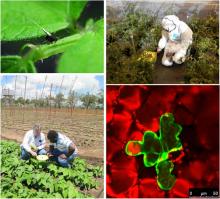The group investigates how virus infection influences interactions of plants with other organisms and plants’ ability to withstand environmental stresses. We found that viruses can alter the interactions of their plant hosts with insects, such as aphids, that vector viruses. This means that viruses may be able to enhance the rate at which they are spread between plants. We have also found evidence that viruses may ‘pay back’ susceptible hosts by making infected plants more resilient to drought or making the plants more attractive to pollinators. In collaboration with partners in sub-Saharan Africa the group has explored ways of translating our basic research into novel approaches to disrupt insect-mediated virus transmission. We work at multiple scales to understand how viruses manipulate plants and the interactions of plants with other organisms. Topics of interest include:
-
Do viruses manipulate plant-aphid interactions to facilitate insect-mediated transmission?
-
Does virus infection affect interactions with other organisms in the environment including beneficial ones?
-
How do signaling pathways mediated by salicylic acid, jasmonic acid and inositol phosphates work together to maintain resistance to pathogens?
-
How are signaling pathways mediated by salicylic acid, jasmonic acid and inositol phosphates sometimes subverted by pathogens, in particular viruses?
Understanding how viruses cause disease symptoms
Figure 1. Three tobacco plants infected with cucumber mosaic virus (CMV), a mutant of the virus (CMV∆2b), or treated with a control solution (‘mock’ inoculation). CMV infection causes severe stunting of plants but disease is absent in the plant infected with the mutant virus CMV∆2b. This mutant is unable to express an important CMV factor called the 2b protein, which among other things, is an important determinant of disease symptoms.
Probing the behaviour of virus-transmitting insects
Figure 2. An aphid (Myzus persicae) feeds on the surface of an Arabidopsis thaliana leaf. The insect is attached to a fine gold wire to allow its feeding behaviour to be monitored electronically in real time. Studies like this allow us to understand how virus infection alters the feeding behaviour of these insects. This is important because aphids transmit many plant viruses. (Image credit: Dr Jack Westwood).



